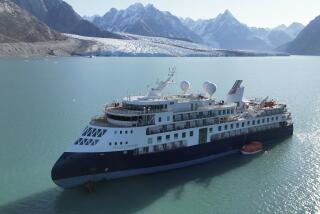Soviet Sub Recovery Effort Predicted by NATO Aides : They Expect Attempt to Retrieve All or Part of Lost Boat, Especially Its Nuclear Elements
- Share via
OSLO — Soviet research ships hovered Monday at the site in the Norwegian Sea where an advanced, experimental nuclear submarine sank three days earlier, and senior NATO officials here forecast a major Soviet effort to recover all or parts of the vessel.
“I think the Soviets will make every effort to retrieve the two nuclear torpedoes at the very least,” a senior naval official from the headquarters of the North Atlantic Treaty Organization said in an interview here. “But I think they will also try very hard to recover the whole submarine--and the two reactors on board.”
Information in the West indicates that the one-of-a-kind submarine, which sank after a fire and explosion Friday with the reported loss of 42 of its 69 crew members, carried twin reactors, but Soviet officials, in discussing the incident, have referred only to a single reactor.
The NATO official said that “no one knows” the condition of the submarine’s wreckage, adding, “It would be a very, very difficult salvage operation but it is do-able.”
In Moscow, Soviet Foreign Ministry spokesman Gennady I. Gerasimov told a news conference: “The question of lifting the submarine has not been decided. It’s a bit deep out there.”
May Be on Rocky Slope
The submarine went down in waters estimated to be at least 4,500 feet deep, probably landing on the rocky slope that extends from the shallow Barents Sea westward to the deep canyons of the Norwegian Sea.
The Soviet government newspaper Izvestia reported Monday that because the submarine experienced “several explosions” before it sank, “it is possible that the hull was cracked in a series of places.”
Western naval officials here said this might mean that the wreckage is scattered around the sea bed--but also that it might ease retrieval of the reactors and the torpedoes, making it unnecessary to attempt raising the entire boat.
The Norwegian government said Monday it considers the sunken vessel to be Soviet property, implying that there would not be any Norwegian attempt to salvage it. Under international law, a vessel that sinks in international waters is legally fair game for any salvager.
NATO officials said they believed the U.S. Navy would not try to get to the Soviet submarine first, although it is thought to contain the latest Soviet underwater warfare technology.
“There is an obvious temptation for covert action,” said one senior NATO official. “We think the submarine has new liquid metal-cooled reactors, the latest propulsion equipment and a titanium hull.”
According to Western intelligence sources, the submarine, the only one of a class dubbed “Mike” by NATO experts, had the ability to dive almost twice as deep as comparable American submarines.
Nonetheless, the senior NATO naval official said: “I think it’s very unlikely that the United States would attempt to get to the submarine because of glasnost (the new Soviet policy of openness). Besides, there is a tacit agreement that you don’t interfere with the other country’s disasters.”
In 1974, however, the CIA used a secretly equipped vessel, the Glomar Explorer, to recover parts of a Soviet submarine armed with nuclear weapons that had sunk six years before in the Pacific. The recovery effort followed years of searching for the wreck, which the Soviet navy apparently was unable to find.
A naval officer here said the exact position of the submarine that sank Friday would be known to the Soviet navy, and to NATO, too, and that its position was probably marked by floating buoys.
Wide Range of Salvage Vessels
Naval experts here said that because of the many accidents to its submarine fleet over the years, the Soviet navy has a wide range of salvage vessels. Mini-subs, carried by surface or submersible vessels, can be released to dive to the sunken submarine to explore the wreck and take photographs so that the Soviet navy could decide how best to go about a salvage operation, the NATO experts said.
“I think they will spend a lot of their resources to recover the submarine,” said the senior NATO naval official, “if only because they are afraid of giving away their secrets.”
However, said the source, U.S. intelligence devices, including American submarines, are sure to monitor in some way the progress of any Soviet salvage operation.
Meanwhile, the Norwegian Foreign Ministry sent to Moscow a list of 10 questions drafted by its Committee on Radiation Accidents, which was created after the 1986 Chernobyl nuclear power plant accident in the Ukraine. The questions seek information about the nature and construction of the nuclear power plant, cooling system and possible waste materials aboard the submarine--and asking what the potential dangers were.
“We are not trying to pry into their military secrets,” said government spokesman Sigrid Romundset. “But we are concerned about other circumstances of safety.”
Water Samples Taken
A Norwegian vessel took deep-sea water samples Monday, but authorities said they did not expect to have the samples analyzed in Oslo for possible radioactive contamination before Friday.
NATO officials said they doubt that the sinking would necessarily release any significant amounts of radiation.
“We have seen nuclear weapons and power plants sunk before,” said an official, “and they didn’t produce any major pollution that could be found.”
Vadim Rozanov, press attache at the Soviet Embassy in Oslo, said Soviet vessels were in the area to test for radiation, which remained normal.
The official news agency Tass said an investigating commission already has determined that “the submarine’s crew acted courageously . . . to keep the submarine afloat to the very last moment. They managed to shut down the reactor and ensure complete radiation safety when the tragic outcome became inevitable.”
According to Izvestia’s account of the disaster, the original fire was started “apparently” by a short circuit. But Gerasimov said the government commission had not yet determined what caused the fire.
Izvestia, reporting from Murmansk, headquarters of the northern Soviet fleet, quoted Defense Minister Dmitri T. Yazov as saying “the crew heard several explosions” after two or three hours of trying to control the fire.
The paper reported that four sailors went down with the submarine and that rescue teams had found 19 bodies on the surface. The submarine’s captain, Ye. Vanin, whose fate was previously unknown, was among the dead, it said.
It was not clear what happened to the rest of the victims--whether they died from the fire, the explosions or immersion in the freezing Arctic waters, the paper continued.
“Those who were saved are in serious condition,” said the paper. “One was in icy water for more than an hour.”
Izvestia quoted Yazov as attributing the explosions to unspecified “special devices.”
“It may be supposed that with the increased pressure on the sub, special devices began to explode,” the defense minister said. “There were a total of seven of them on board. It is possible that the body of the sub cracked in some places.”
Times staff writer Masha Hamilton, in Moscow, contributed to this report.
More to Read
Sign up for Essential California
The most important California stories and recommendations in your inbox every morning.
You may occasionally receive promotional content from the Los Angeles Times.










